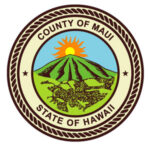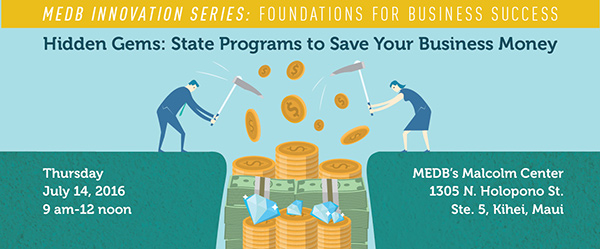
Jul 13, 2016 | Education, Small Business

MEDB offers a powerful workshop to help you save money. Discover TWO State Department of Business, Economic Development and Tourism (DBEDT) programs that can benefit your business:
Enterprise Zones (EZ) Partnership Program
If your new or existing business is located in an Enterprise Zone (EZ), you may be eligible to receive various state tax credits and benefits for up to 7 years, including:
- 100% exemption from the General Excise Tax
- Up to 80% non-refundable state income tax credit
- Up to 80% tax credit for Unemployment Insurance premiums
Hawaii State Trade and Export Promotion Assistance Program (HiSTEP-AP)
Under HiSTEP-AP, your company could receive direct awards to participate in export marketing activities. Applicants may request a minimum of $2,000 and a maximum of $6,000 for various business activities including trade shows, travel, collateral materials, compliance testing, shipping, and other expenses.
Workhop Speakers
The workshop is free. Breakfast will be provided. Reservations are required, space is limited. It is part of the MEDB Innovation Series, Foundations for Business Success.
Thursday, July 14, 2016 • 9 am – 12 noon
MEDB’s Malcolm Center, 1305 N. Holopono Street, Suite 5, Kihei

Jun 30, 2016 | Education, Stemworks

You are invited to attend Pathways to our Future, a benefit for the MEDB Ke Alahele Education Fund.
Bid on hundreds of items during the “Apples for Education” Live & Silent Auctions
Play Family Feud, The STEM Edition
Mingle with Distinguished Educators:
- U.S. Senator Mazie Hirono
- U.S. Senator Brian Schatz
- Lt. Governor Shan Tsutsui and Lyndelle Tsutsui
- Mayor Alan Arakawa and Ann Arakawa
Sponsorship opportunities are available.
Saturday, August 20, 2016 • Fairmont Kea Lani, Maui
4:30 pm Reception/Silent auction • 6 pm Dinner/Live auction
For reservations, visit www.medb.org or call us at 808-875-2300.
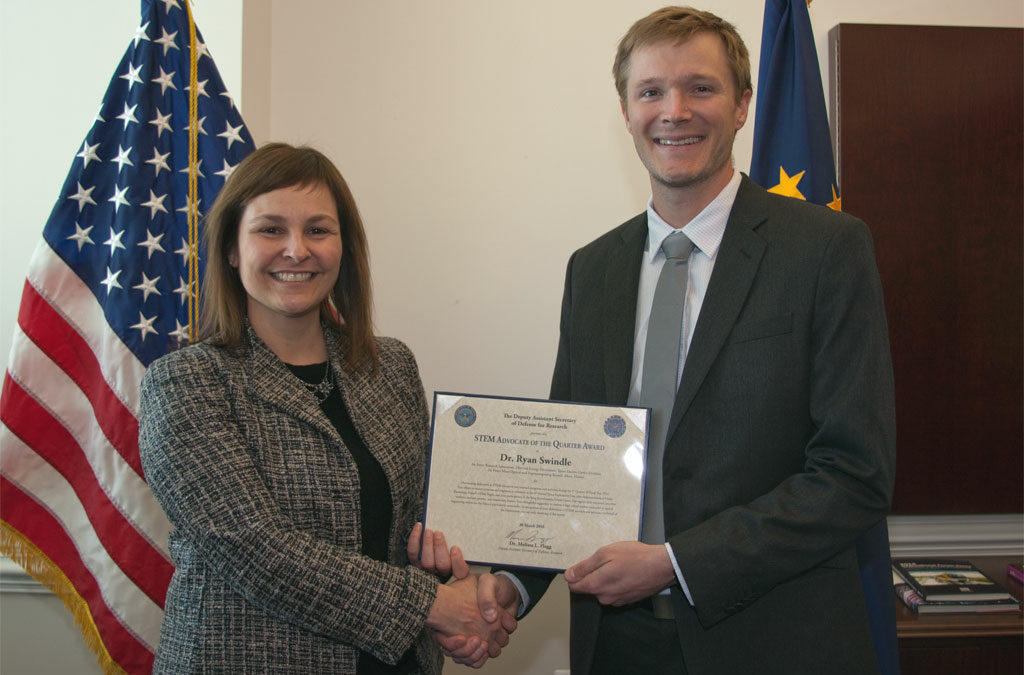
Jun 23, 2016 | Education
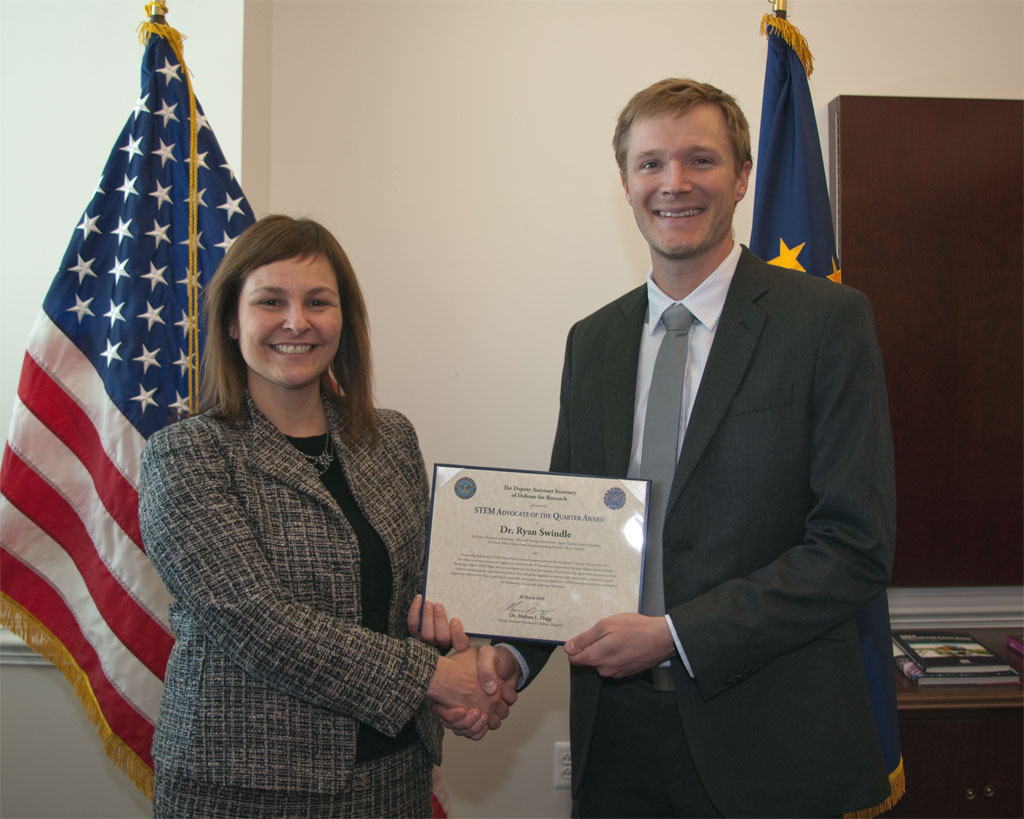
This March, Dr. Ryan Swindle of Air Force Research Laboratory (AFRL), Maui Detachment, received the Department of Defense STEM (Science, Technology, Engineering and Math) Education and Outreach Advocate Award for his dedication to STEM education in the Maui community. “Swindle has established himself as a role model and leader in STEM outreach and educational efforts in K-12 activities, teacher education, and internship programs,” said Dr. Stacie Williams, former AFRL STEM Outreach Director. “His accomplishments in the Maui community are numerous.”
Swindle, a research physicist at the Air Force Maui Optical and Supercomputing Site (AMOS), worked with the University of Hawaii to acquire a 50-person planetarium. “Our new AFRL 50+ capacity, portable, digital planetarium demonstrates to students and educators, the importance of ground-based astronomy across the world,” Swindle said. Recently, at the 2016 Maui Economic Development Board’s (MEDB) Hawaii STEM Conference, he brought the planetarium to teach students how to understand astronomical coordinate systems, use important points to find stars, planets, and even satellites. Additionally, this year Swindle provided physics laboratory demonstrations for over 60 students and parents at a local school and attended school career days. He is also mentoring two college students this summer, one from the University of Hawaii, Hilo and the other from the University of Arizona.
“My vision for the future of the AMOS STEM Outreach program is to build upon the efforts of our former STEM Outreach Director, Dr. Stacie Williams,” said Swindle. “Her great work is known all over the County of Maui.” Swindle hopes to continue efforts with K-12 optics, lasers, and color and light activities, as well as annual participation in AMOS Space Exploration Day and the MEDB STEM Conference. “Partnering with MEDB, AFRL hopes to increase public awareness of the AMOS mission, extend outreach efforts to neighbor islands, and inspire local students to work in Hawaii,” he said.
“MEDB looks forward to our future work with Swindle,” said Mapu Quitazol, MEDB Program Manager Women in Technology (WIT) Project. “His insights and leadership inspire future collaborations with WIT’s STEM education outreach programs.”
I am honored to be able to encourage students to pursue careers in STEM education to find innovative solutions for the challenges we are all facing.
Dr. Ryan Swindle, AFRL Research Physicist

Jun 9, 2016 | Education, Stemworks
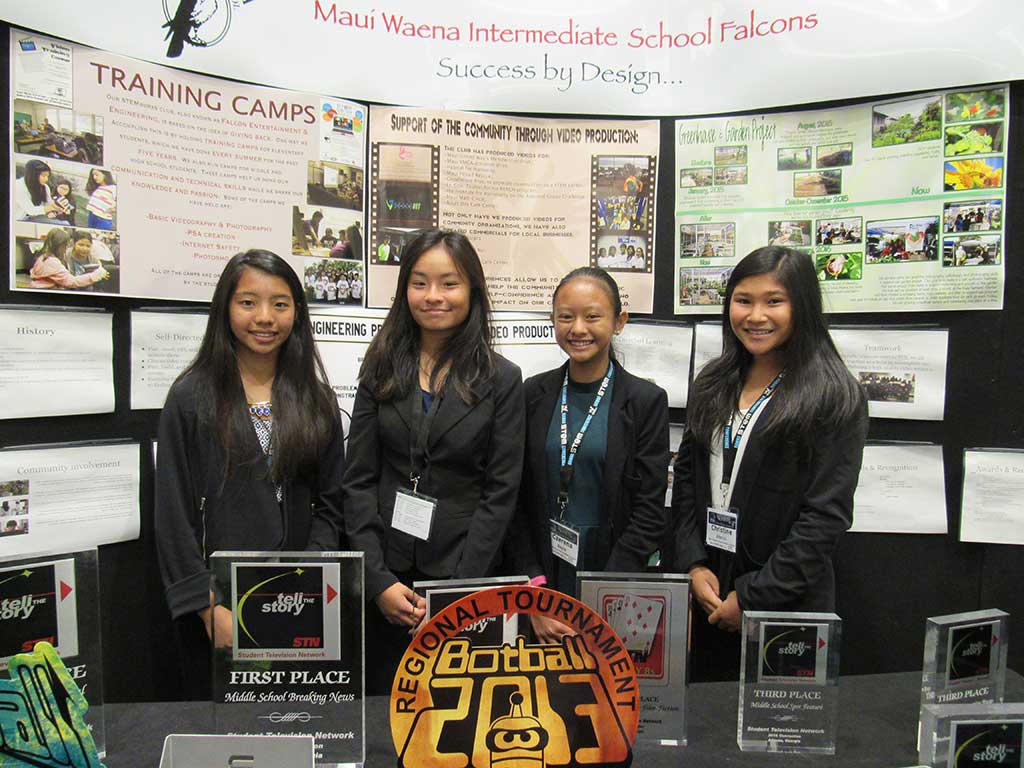
In 1999, Maui Economic Development Board (MEDB) created the Women in Technology Project (WIT) whose mission is to promote science, technology, engineering, and mathematics (STEM) throughout the state with hands-on and project-based service learning. WIT works in partnership with educators and businesses to build and strengthen Hawaii’s STEM education- to-workforce pipeline. Today, WIT provides cutting-edge STEM education across the islands, throughout the year. Effective programs, such as STEMworks AFTERschool, the Annual Hawaii STEM Conference, and more, continue to meet 21st century workforce demands. “STEM education has the power to impact all of us,” said Isla Young, MEDB’s K-12 STEM Program Director. “Through the years, we’ve seen first-hand how empowering our youth with STEM skills and opportunities can make a difference in their lives and in the career pathways they choose to pursue.”
WIT’s STEMworks AFTERschool program is multi-faceted and hands-on. Students get to use the most current, high-end technologies in actual service learning projects. Participants work with their peers and industry partners, using their skills to help improve life on their respective islands. “Through the STEMworks program, I’ve been able to strengthen my love for computer programming,” said Jeremy Amato, a 12th grader at King Kekaulike High School. “STEMworks has allowed me to apply my skills to real-world jobs and even use it to help my community. Now I’m looking at pursuing computer programming as my career choice.” Maui Waena 8th grader Christine Alonzo said, “The STEMworks AFTERschool program taught me how to work a camera. I now know how to write scripts, edit, and use Photoshop. But mostly, I learned the importance of teamwork.”
“We have the power to change the world,” said Thanthawat Moengchaisong from King Kekaulike High School. “I personally love helping the community with the technology around me because STEM is all over the world and it connects people in a powerful way.”
Through STEMworks AFTERschool, I achieved more than I ever thought I could. With the support of MEDB and WIT, my partner and I won first place in a nationwide film competition. Thank you MEDB!
Czerena Bayle, Maui Waena Intermediate School 8th grader
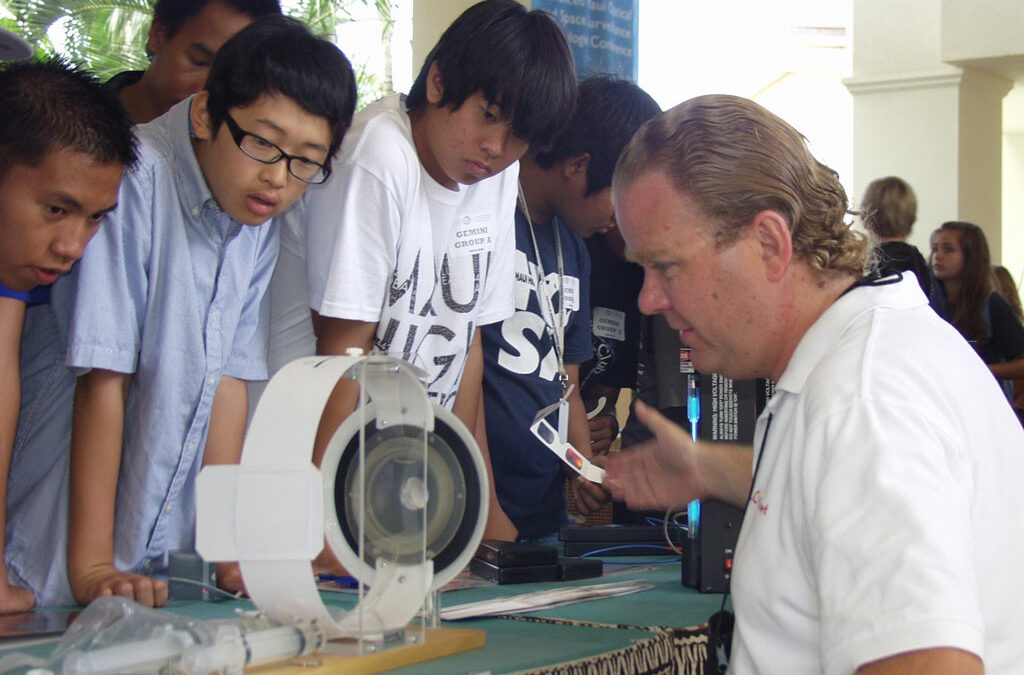
Jun 2, 2016 | Education
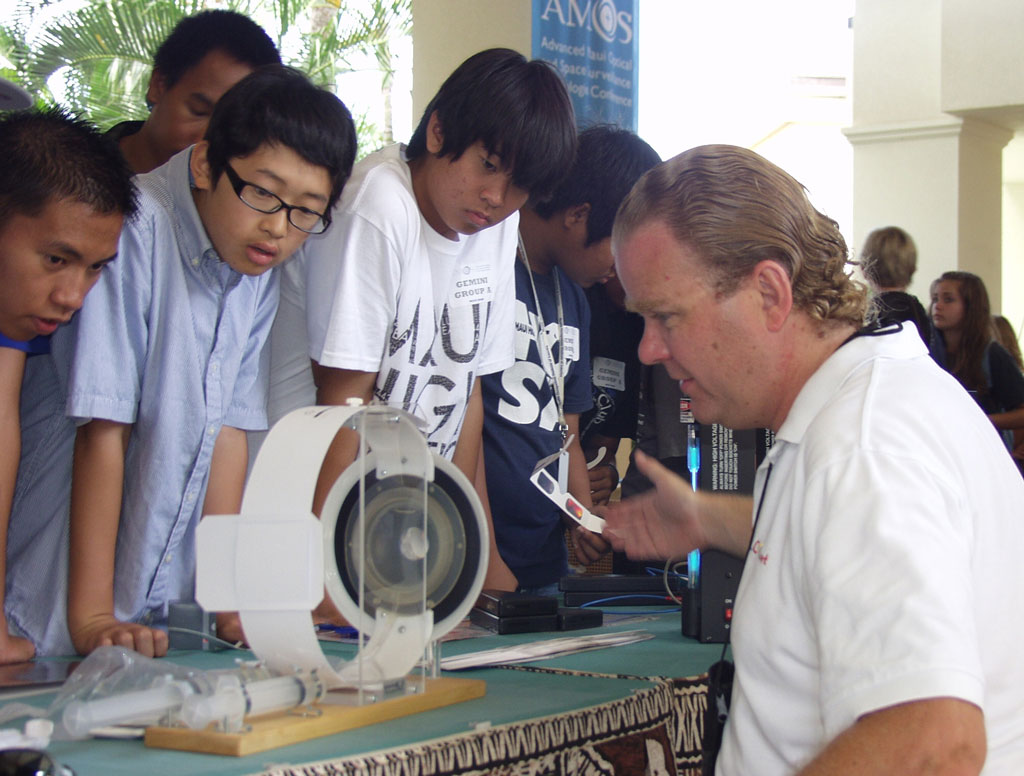
Dr. James “JD” Armstrong, the enthusiastic Maui Technology Education and Outreach Specialist at the University of Hawaii’s Institute for Astronomy (IfA) in Pukalani, is much admired in the community. His work includes research on exoplanets, asteroids, comets, stellar objects, double stars, besides monthly public talks at IfA. “A highlight of my job is mentoring students and assisting with their science projects,” said Armstrong, who manages UH’s time on the Faulkes Telescope North (FTN) atop Haleakala. Owned and operated by Las Cumbres Observatory Global Telescope Network, FTN offers students live views of outer space streamed straight to their computers. “Students remotely observe the sky as it is seen from different parts of the earth via the telescope network,” Armstrong explained. “Using Astrometrica, a software tool that calculates precise positions of the celestial bodies, they are able to analyze the collected image data.”
“JD’s Hawaii Student/Teacher Astronomy Research (HI STAR) summer science program for high school students is unsurpassed, as evidenced by the success of the students,” said Dr. Joe Janni, former Director of the Air Force Office of Scientific Research. “He is a dedicated and enthusiastic mentor who counsels and motivates young astronomers to achieve high honors and numerous awards. His ability to inspire and recognize their potential is unmatched.”
“Armstrong has been a partner of Maui Economic Development Board (MEDB) for over 10 years,” said Mapu Quitazol, MEDB project manager. “Recently he has had students receiving recognition for their science projects. In March at the Hawaii State Science and Engineering Fair, Armstrong’s HI STAR students captured numerous awards.”
“I’ve been very fortunate to have Dr. Armstrong as my mentor for the last five years,” said Celeste Jongeneelen, home-schooled 10th grader and 2016 first-place Physics and Astronomy winner. “He’s encouraged my interest in hypervelocity stars; stars thought to originate when a binary system encounters the supermassive black hole in our Milky Way. Dr. Armstrong has motivated me to better understand the age and classification of these stars. He has given me the confidence to think that I could actually discover something new about the Universe!”
Astronomy is a great way to spread interest in all subjects and motivate learners to pursue science, technology, engineering and mathematics (STEM) to better comprehend the world around us.
Dr. JD Armstrong, Maui Technology and Education Outreach Specialist, University of Hawaii Institute for Astronomy
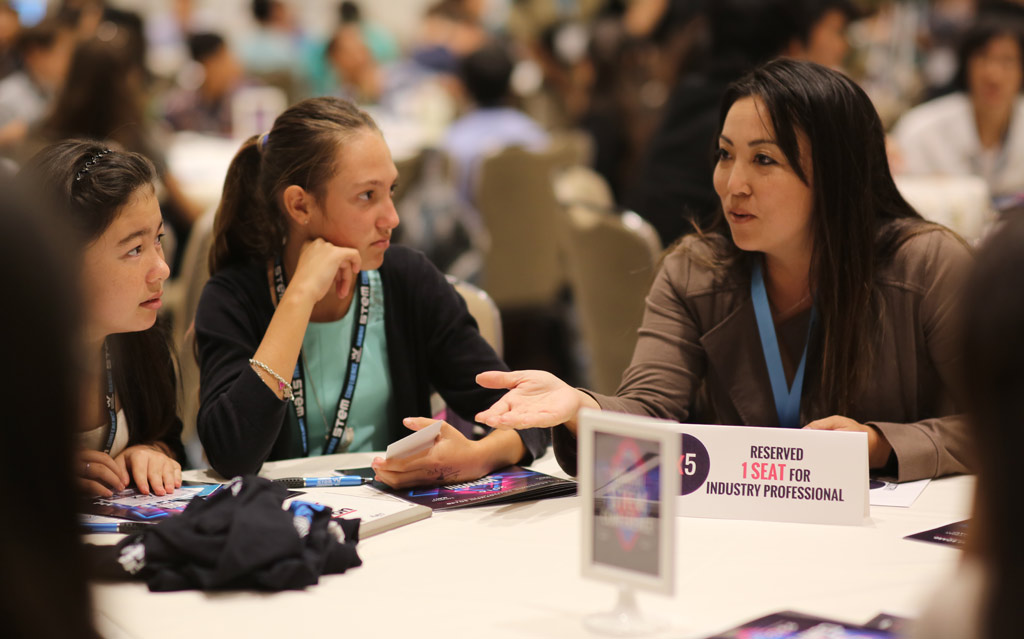
May 20, 2016 | Education, Stemworks

Maui Economic Development Board’s Women in Technology (WIT) Project, in partnership with the County of Maui, presented the 7th Annual Hawaii STEM Conference at the Wailea Marriott Resort on May 6-7. This year, over 880 students, teachers, and industry professionals, offering some of the most innovative global technologies, attended. “Science, technology, engineering, and mathematics (STEM) education has the power to impact all of us,” said Isla Young, MEDB’s K-12 STEM Program Director. “Through the years, we’ve seen first-hand how empowering our youth with STEM skills and opportunities can make a difference in their lives and in the career pathways they choose to pursue.” The two-day, “download knowledge, upload service” themed event featured 43 student breakout sessions, 16 teacher professional development breakout sessions, 15 STEM competitions, a formal awards banquet, and STEM exhibit presentations.
Kicking off the event on Friday, a timed, high-energy mixer, the 5×5 Sessions, gave students the opportunity to engage five different STEM industry professionals in a ‘speed networking’ format to learn about STEM career pathways, personal experiences and insights. “MEDB’s leading effort to inspire these young minds during the annual STEM Conference, in addition to their STEMworks AFTERschool Programs, is simply amazing and greatly appreciated,” said 5×5 industry participant Kimberly Vaitu’ulala, an engineer with Maui Electric Company. “Each year Maui Electric welcomes students from WIT programs. We offer a hands-on science project that thrills participants when they finally get their circuits working!”
During the Conference, Hawaii State Governor David Ige announced that two new Microsoft “Digi Camps” will bring the latest in advanced code training to students in Maui County next year. The County and MEDB’s WIT Project are working closely with Microsoft to develop the Digi Camp agenda and promotion to local schools. “Forming an official Digital Alliance with Microsoft is a significant step toward building Maui County’s future workforce,” said Maui County Mayor Alan Arakawa.”Given the latest challenges to our island’s economy, these kinds of educational opportunities can have a lasting impact.”
Every day, our lives are becoming more dependent on technology, which is why in this day and age, STEM education in the K-12 classroom is so important. The 5×5 Session is our chance to inspire the youth of Hawaii, by giving them face-to-face contact with people in STEM careers and hands-on experience with today’s technology.
Kimberly Vaitu’ulala, Maui Electric Company Engineer

May 12, 2016 | Education, Stemworks

Dr. Stacie Williams
Dr. Stacie Williams, a leading scientist and STEM (science, technology, engineering and mathematics) outreach educator in the Air Force Research Laboratory (AFRL) Directed Energy group on Maui, has accepted a position with the Air Force Office of Scientific Research near Washington DC. During her seven years here, Williams has skillfully juggled a myriad of professional responsibilities in a challenging environment. She led several technical efforts in the areas of imagery, spectroscopy and lasers and has been the manager for AFRL’s daylight and geosynchronous earth orbit imaging programs. As the AFRL group’s STEM outreach director, Williams’ leadership was instrumental in developing a program that annually reaches more than 1,000 kindergarten through 12th grade students and teachers, and influences all 34 Maui County public schools. The program includes teacher development workshops, a STEM curriculum lending library, and opportunities for summer students. “It’s important to show our youth that science can be engaging and that they don’t have to leave Maui to work in high-technology jobs,” said Williams.
“Since 2009, Williams has been a leading advocate in securing Air Force funds to supplement Maui Economic Development Board’s (MEDB) Women in Technology project STEM outreach programs,” said Mapu Quitazol, MEDB project manager. “She has also provided insights on high quality laboratory sets that are available for teachers to borrow from our STEM lending library. We will greatly miss her and her leadership in STEM outreach!”
Williams is featured in the film Maui in Space produced by MEDB with support from the County of Maui. Along with other AFRL officials and with researchers from the University of Hawaii’s Institute for Astronomy, the film introduces the importance of astronomy on Maui. “The video, an extraordinary educational tool, shows how our basic everyday needs require space-related functions and Maui’s important contributions to it,” said Williams. “Our goal, along with MEDB, is to continue to educate teachers and inspire students to explore the STEM fields for Hawaii’s future.”
“Working for the Air Force as a scientist is an honor,” Williams added. “I believe the AFRL and MEDB STEM programs will have a far-reaching impact on the future of our youth. I will miss Maui!”
By developing STEM programs for our youth, AFRL and MEDB are working together toward engaging Maui students at an early stage to use technology for improving Hawaii’s future.
Dr. Stacie Williams, AFRL Scientist and Outreach Education Director
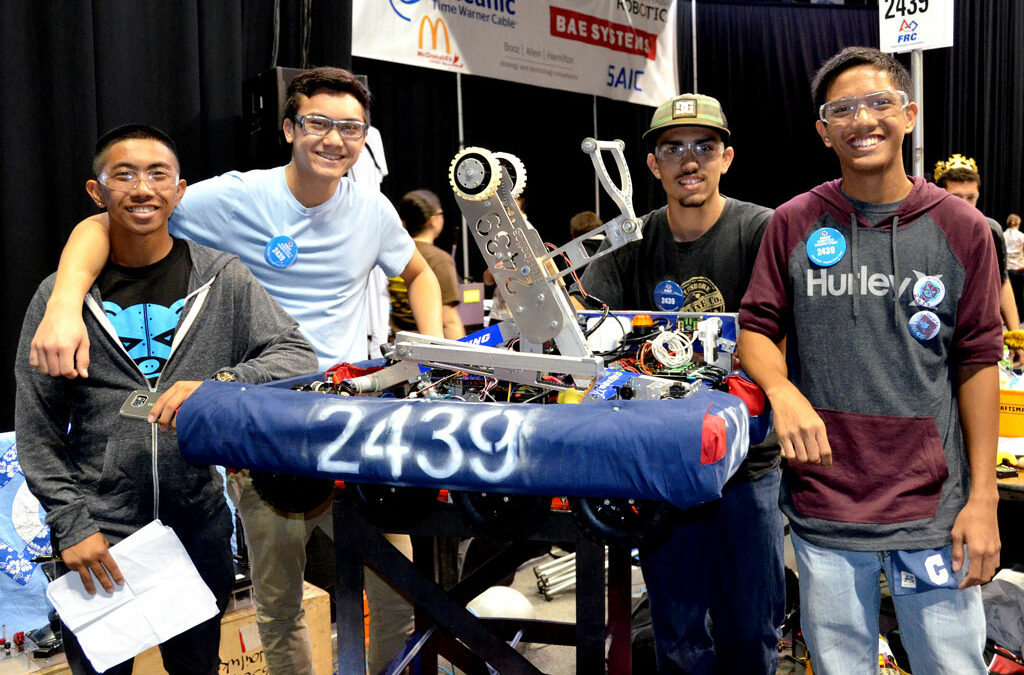
May 5, 2016 | Education
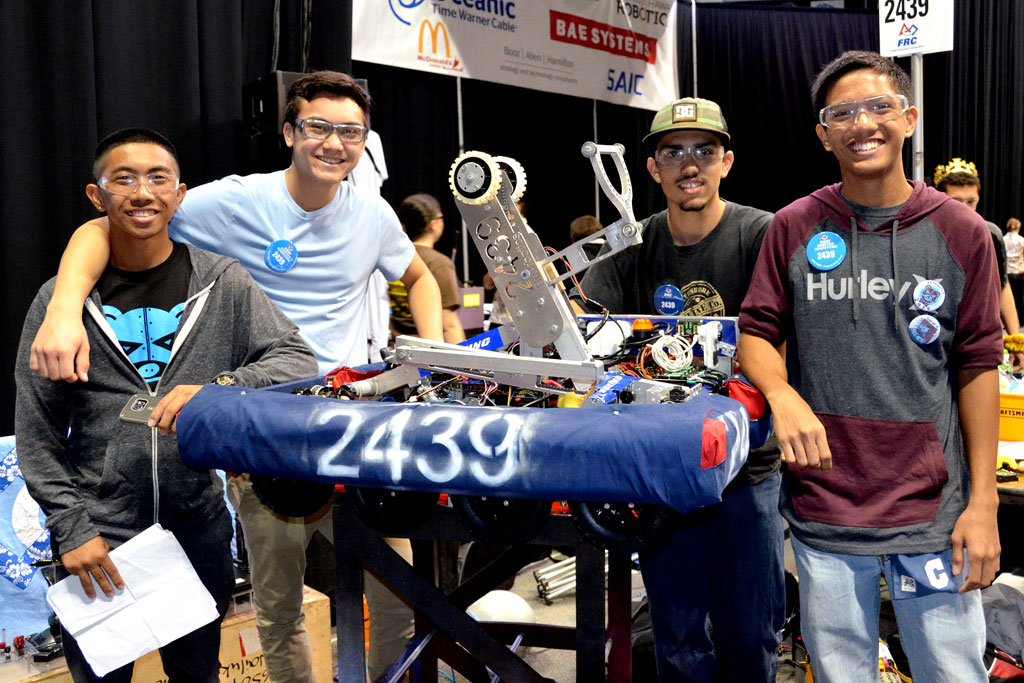
The Ke Alahele Education Fund of Maui Economic Development Board (MEDB) supported Baldwin High School’s Robotics Team to compete at this year’s FIRST (For Inspiration and Recognition of Science and Technology) Robotics competition, an international high school robotics contest. Baldwin Robotics was established to encourage students in science, technology, engineering and mathematics (STEM) subjects. The program provides hands-on educational experiences and life-long skills in problem solving, teamwork and leadership. “Our students learn to use equipment, tools and machines to build mechanical, electrical, and software systems,” said Gary Suter, career and technical education teacher at Baldwin High School and head advisor for Baldwin Robotics. “They also learn to use real-world STEM applications by researching, collaborating, designing, building, testing and evaluating robots for FIRST Robotics Competitions and VEX Tournaments.”
On April 1-2, Baldwin Robotics participated in the 2016 FIRST Hawaii Regional Competition in Honolulu, alongside 38 teams from around the world. During the competition, Baldwin Robotics, seeded third, formed an alliance with teams from Iolani High School and Kapolei High School. These three teams rallied together to take the crown, and will be participating in the 2016 FIRST World Championship in St. Louis, Missouri, April 27-30. “All parts of the team were really firing on all cylinders,” said Baldwin senior Dylan Copley. “We wouldn’t have been able to win without the hard work and dedication of the drivers, builders and scouts.”
This is Baldwin Robotics’ ninth year in FIRST Robotics and their third win in the past five years. “As a senior, it’s been great to see the team grow and achieve what we have this past season,” said scout Iris Lei Sanchez. “I thought it was cool to see our sketches come to life,” said senior and builder Sabrina Nassar. “Everyone contributed to the robot in their own way.” Mentor Suter said, “In my eight years of coaching robotics, I’ve never come across a better team that exhibited more passion and teamwork. I feel honored to have been able to work with these students. They are a testimony to their STEM educational programs made available through MEDB and community sponsorship.”
We wouldn’t have been able to achieve such a high level of excellence without the support of MEDB and all of our sponsors. I couldn’t have asked for a better team.
Evan Grimes, Baldwin High School Robotics Team captain, builder and driver

Apr 28, 2016 | Education, Stemworks

In recognition of the 7th Annual Hawaii STEM Conference, the Maui County Council has declared the week of May 2 as Hawaii STEM Education Week. The Maui Economic Development Board’s (MEDB) Women in Technology (WIT) Project is sponsoring the conference on May 6 and 7 in partnership with the County of Maui. STEM (science, technology, engineering and mathematics) subjects empower students and educators with first-hand exposure to advanced technologies and the latest software training. Since the WIT program began in 2000 as a Maui pilot, it has grown to include every island, involving over 40,000 students and teachers annually. “STEM education has the power to improve all of our lives,” said Isla Young, K-12 STEM Director. “Our hope is that by equipping our youth with the right skills, tools, and opportunities we can inspire our next generation of innovators, ensuring a bright future for our community, and our world.”
Each year, the event also attracts prominent national partners and sponsors from top technology companies like Microsoft, Google, National Geographic, Apple for Education, Office of Naval Research, SketchUp, Opterra Energy Services and Environmental Systems Research Institute. This year the conference welcomes for the first time the National Security Agency, the National Science Foundation, and Cyber Watch West. The 2016 conference theme, “Download Knowledge – Upload Service,” encourages students to do innovative thinking and to demonstrate solutions to complex problems. The two-day event will feature 43 student sessions, 17 teacher sessions (designed to motivate and increase STEM learning in the classroom), 14 software competitions, a formal awards banquet, and STEM exhibit presentations. A number of student-centered competitions before and during the conference will also be held ranging from Computer Aided Design, game design, video, Geographical Information System, and Cybersecurtiy competitions. The event will also feature keynote speakers Teresa Nededog, a web developer for Enhance Digital, and Scot Refsland, Ph.D., founder and CEO of RotorSports.
“The STEM Conference gives students a true hands-on experience with new technology and insight into viable career options,” said Jennifer Suzuki, Maui Waena Intermediate School STEMworks™ teacher and advisor. “It is amazing what MEDB’s WIT team puts together here
in the middle of the Pacific Ocean for our students and teachers.”
MEDB’s WIT project has gone to great lengths to develop and launch STEMworks™ and the STEM conference. I’m very proud of them and all the students who are taking advantage of the opportunities to make all our lives better.
Bob Carroll, Maui County Council member
















